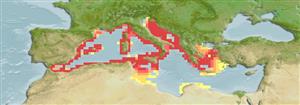Common names from other countries
Environment: milieu / climate zone / depth range / distribution range
Ecologia
; intervalo de profundidade 10 - 1016 m (Ref. 66603), usually 10 - 100 m (Ref. 358). Subtropical
Eastern Atlantic and the Mediterranean.
Length at first maturity / Tamanho / Peso / Idade
Maturity: Lm ? range ? - ? cm Max length : 3.0 cm COLD macho/indeterminado; (Ref. 363)
Arborescent colonies, with growth irregularly divided into all directions, provided with a Hard skeleton calcareous: can exceed 50 cm, but in general less developed. The surface of the ramifications is not smooth. Polyp: reach the diameter of 0.15 cm; they are white and translucent, the cortical fabric being of red color, seldom white or yellow. The skeleton is highly colored of red; more rarely of pink; dark; white red or to black (Ref. 358). Certain colonies: 20 cm height, but intensive fishing makes disappear the largest specimens. Diameter of the base: 3 cm at the largest specimens (Ref. 363).
Hard skeleton calcareous: can exceed 50 cm, but in general less developed. Polyp: reach the diameter of 0.15 cm. Depth: commonly 10 m of depth; currently, it is necessary to go down beyond the 30 m, generally even 40 m, and until several hundred meters of depth (Ref. 358). Maximum depth and common maximum depth from Ref. 122525.
Life cycle and mating behavior
Maturidade | Reprodução | Desova | Ovos | Fecundidade | Larvas
Members of the class Anthozoa are either gonochoric or hermaphroditic. Mature gametes are shed into the coelenteron and spawned through the mouth. Life cycle: The zygote develops into a planktonic planula larva. Metamorphosis begins with early morphogenesis of tentacles, septa and pharynx before larval settlement on the aboral end.
Göthel, H. 1992. (Ref. 358)
Categoria na Lista Vermelha da IUCN (Ref. 130435: Version 2024-1)
Categoria CITES (Ref. 108899)
Not Evaluated
Not Evaluated
Utilização humana
Pescarias: espécies comerciais
FAO - pescarias: landings, perfil da espécie | FishSource | Sea Around Us
Ferramentas
Fontes da internet
Estimates based on models
Preferred temperature
(Ref.
115969): 13.8 - 19.6, mean 17.7 (based on 240 cells).
Resiliência
Baixo, tempo mínimo de duplicação da população 4,5 - 14 anos (K=0.06).
Vulnerabilidade
Moderate to high vulnerability (46 of 100).
Categoria de preço
Unknown.
